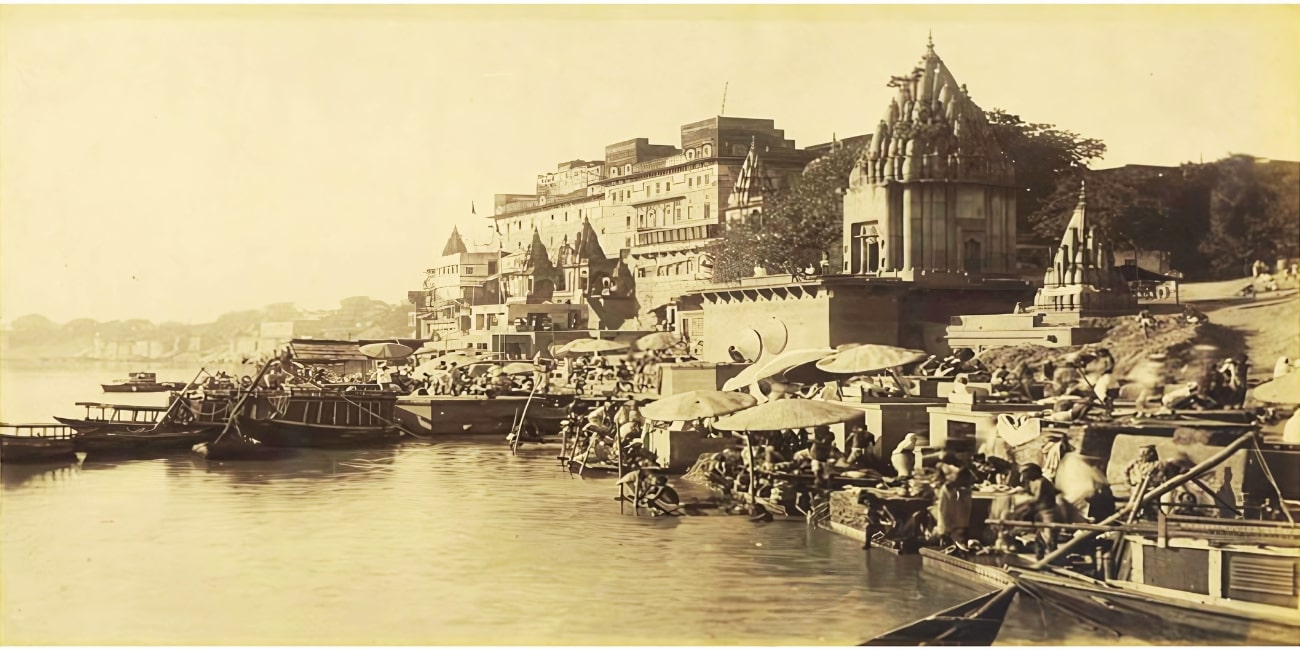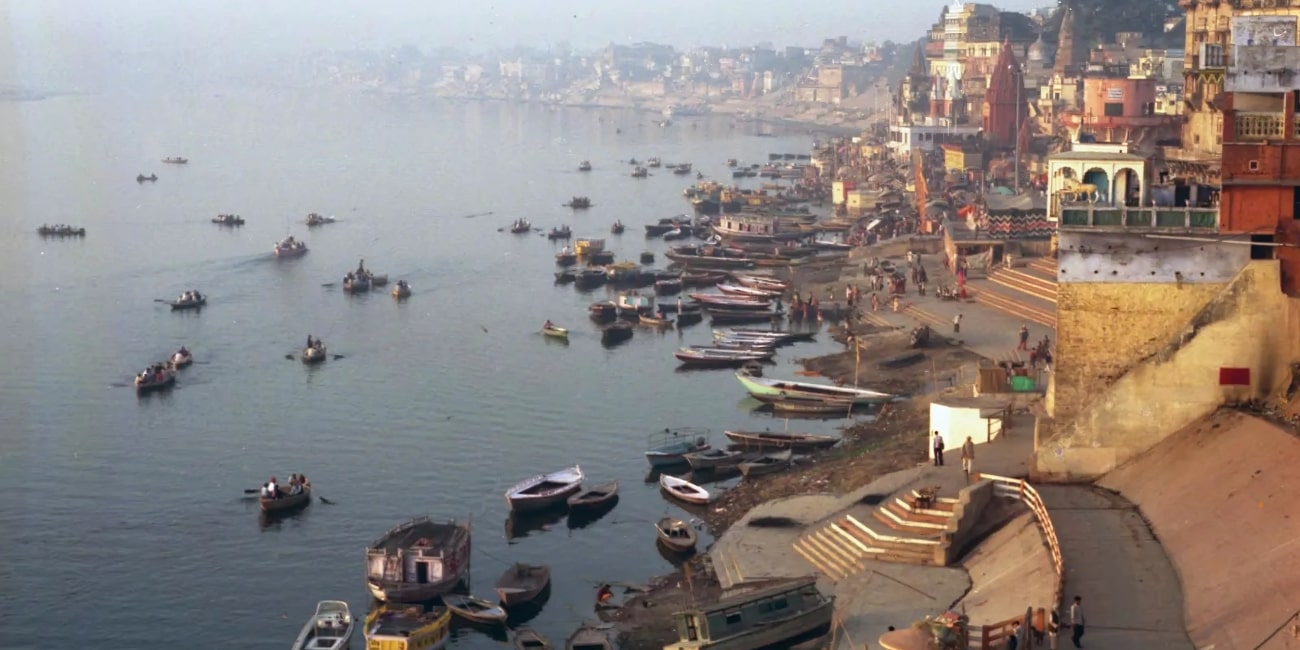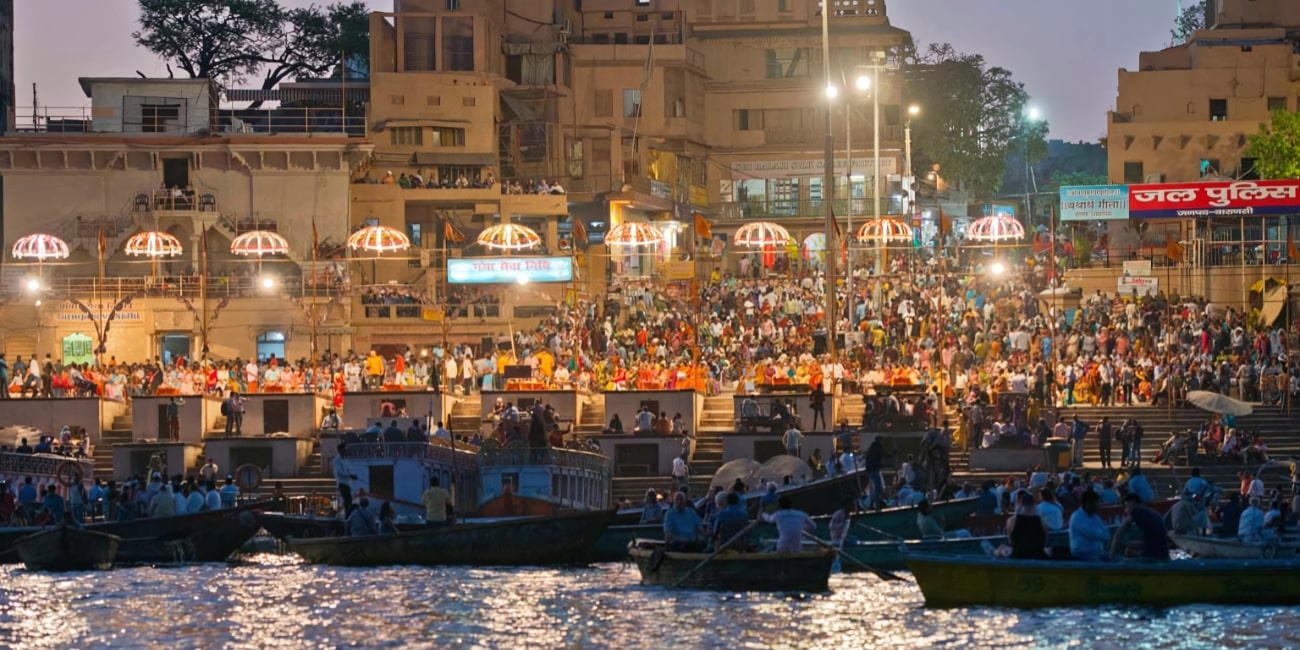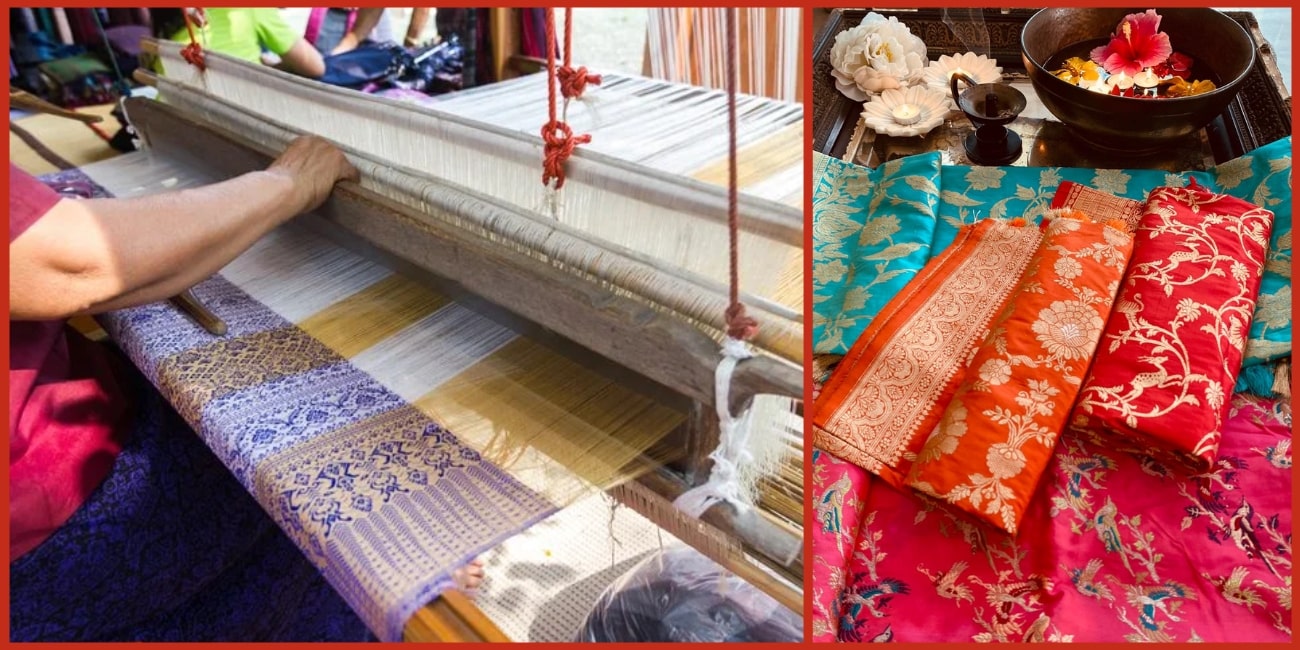Varanasi is a city filled with spirituality, history, and luxury. It's known for its spiritual significance. The city has been a centre of culture and religion for centuries. The Ganges River flows through it, adding to its unique charms. What is special about Varanasi is its seamless blend of ancient traditions and modern spirituality.
The city's history is seen in its amazing architecture. The Kashi Vishwanath Temple is a key landmark. Varanasi is also known for its beautiful Banarasi sarees, a mix of tradition and skill. As a holy city, it draws visitors from all over, seeking its mystique and spiritual vibe.
Varanasi is a city with a rich history and spiritual significance.
The city's unique charms are reflected in its architecture, culture, and traditions.
The Kashi Vishwanath Temple and the Ganges River are significant aspects of Varanasi's spiritual landscape.
Varanasi is famous for its luxurious Banarasi sarees, a perfect blend of tradition and craftsmanship.
The city's holy status attracts visitors from around the world.

Varanasi has been a hub of human life for ages. It has seen empires rise and fall. This city's long life shows its deep historical and cultural value. Archaeologists often ask, ‘What is special about Varanasi?’ as they uncover layers of civilisation beneath its soil.
Excavations in Varanasi have found signs of life from the Indus Valley Civilisation. The city's history is filled with key moments. These include the Buddhist and Jain influences during Ashoka's rule.
Varanasi has been ruled by many empires. Each left its own mark on the city.
Mauryan and Gupta Periods
In the Mauryan period, Varanasi became a centre of Buddhist and Jain learning. The Gupta period saw a cultural and intellectual boom. Varanasi became a key place for Sanskrit scholarship.
"Varanasi is a city that has been a witness to the rise and fall of civilisations, and yet, it continues to thrive." - A renowned historian
Medieval and Colonial Influences
The medieval period brought challenges from invaders. Yet, Varanasi remained a cultural centre. The colonial era brought changes, especially in architecture and administration.
The Kashi Vishwanath Temple is a symbol of Varanasi's spiritual importance. Its history shows the city's ability to keep its culture alive through tough times.
Varanasi is known for its rich history, vibrant culture, and deep spirituality. This ancient city has been a place where cultures and faiths meet. It's a city like no other.
Varanasi is a sacred city for Hindus, Buddhists, and Jains. It's said to be where Lord Shiva lives. The city is filled with temples, ghats, and rituals.
Varanasi has greatly influenced India's culture. It's famous for its classical music, traditional arts, and crafts. The city buzzes with life through its festivals, clothes, and food.
Varanasi is called "The Spiritual Capital of India." Its ghats along the Ganges River are key for spiritual practices. Daily rituals and ceremonies take place here.
The mix of spirituality, culture, and history makes Varanasi a must-see. It attracts visitors from all over the world.

The Ganges River flows through Varanasi's heart, symbolizing the city's spiritual core. Ghats along the river show the city's deep respect for this sacred water. Here, spirituality and everyday life are closely linked.
In Hinduism, the Ganges represents purification and salvation. It's believed that a dip in the Ganges can cleanse sins and help achieve moksha. This is the liberation from life and death's cycle.
"The Ganges is the holiest of rivers, and its waters have the power to purify the soul."
Varanasi's people deeply believe in this. They visit the river for rituals and spiritual comfort.
The ghats of Varanasi buzz with life from dawn to dusk. Devotees perform puja and pray to the river. Others take a holy dip. The riverbanks are also a place for cultural events, like music and dance.
As the day goes on, the ghats turn into a colourful, lively scene. Vendors sell flowers and sacred items, adding to the vibrant atmosphere.
The Ganges faces big environmental problems, like pollution from factories and sewage. To tackle these, efforts like the Namami Gange Programme are underway. This program aims to clean and restore the river.
These conservation efforts are key to keeping the Ganges alive and sacred for the future.
Varanasi's ghats along the Ganges are a colourful mix of rituals, culture, and history. These steps are more than just a place; they are the city's heart, full of life and spirituality. Visitors witnessing the Aarti ceremony often reflect on what is special about Varanasi and its spiritual magnetism.
Dashashwamedh Ghat is famous for its Aarti ceremony in the evening. This ritual, held at the Ganges' edge, is a mix of fire, flowers, and chanting. It's a memorable experience for all who see it.
Varanasi has two main cremation ghats: Manikarnika and Harishchandra. These ghats are key in the life and death cycle. They also hold deep spiritual beliefs.
The Cremation Process and Its Significance
The cremation here is a complex ritual with deep meaning. It's believed that being cremated in Varanasi frees the soul from rebirth.
Etiquette for Visitors
Visitors to the burning ghats must be respectful. Photography is often not allowed. Always follow local rules.
Varanasi has many ghats, each with its own story. From Assi Ghat to Scindia Ghat, they all show the city's rich culture and spirituality.

Varanasi is a city filled with spirituality. It has many temples that show its deep religious roots. These sacred buildings are not just for worship. They also represent Hinduism and other faiths that have shaped the area. Each temple tells a story that answers the question: What is special about Varanasi?
The Kashi Vishwanath Temple is a top Hindu temple in India. It's dedicated to Lord Shiva. For centuries, it has been a key place for pilgrims.
History and Reconstruction
The temple's history is long and complex. It has been destroyed and rebuilt many times. The current temple, built in 1776 by Maharani Ahilya Bai Holkar, is a stunning example of Hindu architecture.
Visiting Information and Rituals
Visitors can see many rituals and ceremonies at the temple. The daily aarti ceremony is a highlight of the day. It's important to follow the temple's rules and traditions when you visit.
Varanasi also has the Durga Temple, known for its red ochre colour. And the Sankat Mochan Hanuman Temple, dedicated to Lord Hanuman. These temples are key pilgrimage sites and show the city's rich culture.
Sarnath, near Varanasi, is a key Buddhist site. It's where Lord Buddha gave his first sermon after enlightenment. The site has many Buddhist monuments, like the Dhamek Stupa and the Chaukhandi Stupa.
As Swami Vivekananda said, "The Ganges, the Himalayas, and the land of Bharata are the three sacred things of India." This quote captures Varanasi's spiritual essence and its surroundings.
The Kashi Vishwanath Temple is a major pilgrimage site.
Sarnath is significant in Buddhist history.
Sarnath is significant in Buddhist history.
Varanasi's temples reflect its rich cultural heritage.
In Varanasi, spirituality is more than just a practice; it's a way of life. The city's ghats and temples are alive with activities. These show the deep spiritual traditions of the area.
A trip to Varanasi isn't complete without a serene sunrise boat ride on the Ganges. Seeing the morning 'Ganga Aarti' is a moving experience. It leaves a lasting mark on your soul.
Visitors can join in on pujas and ceremonies at temples and ghats. These rituals are a chance to seek blessings. They let you feel the city's spiritual energy.
Varanasi is seen as a place for moksha, or freedom from life and death. The city's spiritual importance comes from this belief.
Why Many Hindus Choose to Die in Varanasi
Dying in Varanasi is seen as lucky for many Hindus. It's believed to help achieve moksha. This draws many to the city for spiritual experiences.

Varanasi is known for its beautiful Banarasi silk. This silk shows the city's rich weaving traditions. For centuries, Banarasi silk has been a key part of Varanasi's culture, attracting visitors with its beauty and skill. What is special about Varanasi is its dedication to craftsmanship, especially in Banarasi silk weaving.
The beauty of Banarasi silk comes from its luxurious fabric and detailed designs. These designs show the city's rich culture. Banarasi silk weaving is an art passed down through generations, with techniques and patterns getting better over time.
The history of Banarasi silk weaving goes back to the Mughal era. Royal families supported this craft. The weaving involves intricate hand-weaving on traditional looms, with designs inspired by mythology, nature, and geometry. The use of gold and silver threads makes these textiles even more special.
Banarasi silk weaving is known for its kadua (brocade) work. This is done by inserting weft threads with a needle, creating detailed patterns. This process is very hard and requires a lot of skill and patience, making each piece a work of art.
In Varanasi, you can find many places to buy authentic Banarasi textiles. The Mainpuri and Chowk areas are great for this. It's best to buy from local weavers or reputable shops to make sure it's real.
Popular places include the Varanasi Handloom and Sari Wali Gali. Here, you can find many Banarasi silk products. When shopping, look for the Handloom Mark or Silk Mark to know it's genuine and of good quality.
It's important to support local artisans to keep traditional crafts like Banarasi silk weaving alive. Buying directly from weavers or through fair trade organisations helps these skilled craftsmen. This way, you contribute to their livelihoods.
Fair trade practices make sure artisans get fair pay for their work. This helps keep Varanasi's cultural heritage alive. Organisations promoting fair trade work with local communities to improve their lives.
Varanasi is a city where old traditions meet modern life. It's India's spiritual heart, attracting travellers from everywhere. Here, people find a journey of self-discovery and change.
The city's charm comes from its sacred ghats, temples, and the Ganges River. Visitors can dive into the rich culture, like Banarasi silk and traditional arts. They can also enjoy the local food.
Varanasi offers a deep experience, whether you're looking for spiritual growth, cultural insight, or just to understand its ancient magic. Its power to draw and inspire shows why it's a sacred place.
Varanasi isn’t just a destination—it’s an experience that lingers in your soul. From its spiritual depth to its artistic flair, every corner of the city whispers stories of timeless wonder. And if you're planning to immerse yourself in this magic, choosing the right stay can elevate your journey. Stay Banaras offers a boutique experience that blends heritage charm with modern comfort—perfect for travellers seeking authenticity with a touch of elegance.